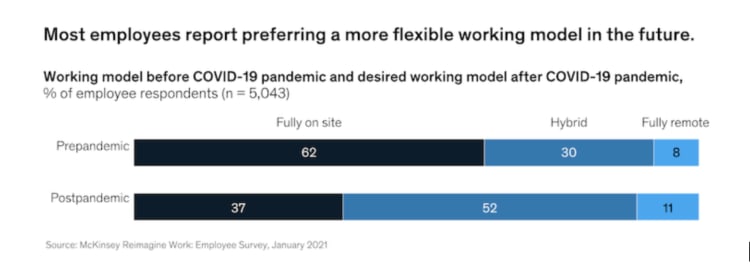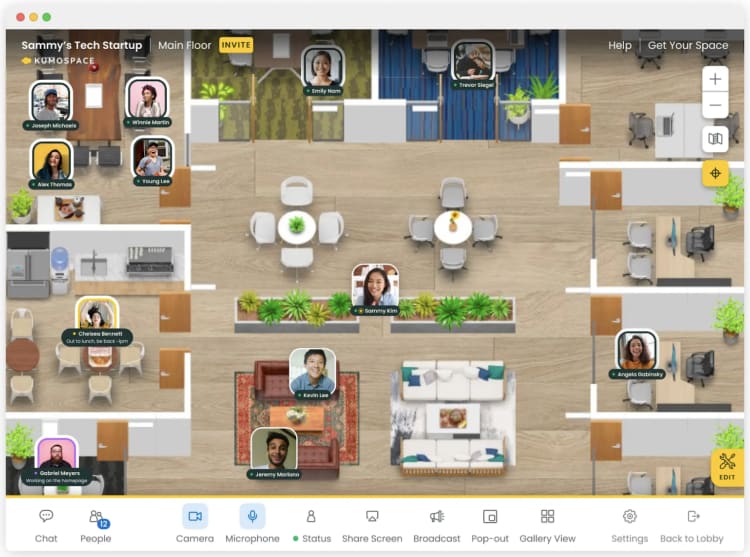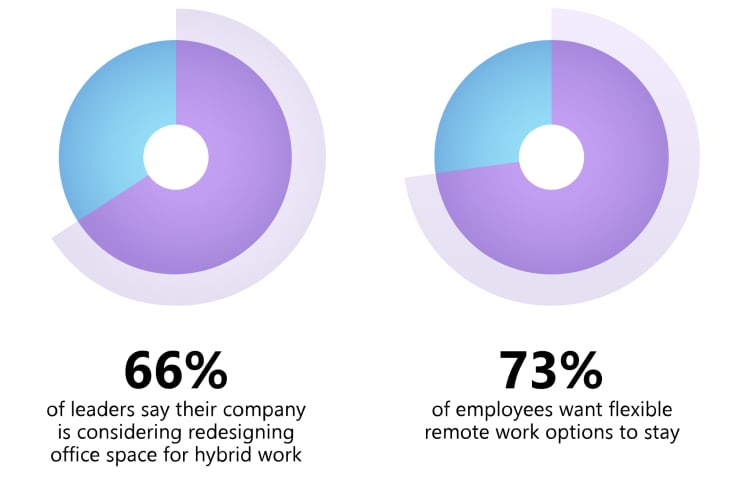The way the world works is going through rapid change. Many are asking what the right organizational strategy for their company is? This guide focuses on addressing what is a hybrid workplace. There are four major workforce strategies to choose from. Hybrid work was born out of the global pandemic and is the most commonly adopted strategy in the post-pandemic world. Here are the four primary organizational strategies.
- In-Office (1900s): This strategy centers around employees commuting daily to a centralized location to perform their job. It became the predominant workplace structure as Western economies transitioned from agricultural economics to industrial and service economies during the end of the 1800s and the start of the 1900s.
- 100% Remote (~2000): An organizational strategy that allows employees to work from anywhere, sometimes in drastically different time zones. A key component of 100% remote work, sometimes referred to as fully remote, is that employees may never physically meet one another during their time with the company. This strategy came into existence with the rise of the internet in the late 1990s and early 2000s. Originally, the workplace strategy was dubbed telecommuting, a reference to the telecommunications infrastructure that supported its existence. For the first time in history, humans could instantly communicate with email and share files across the internet. Over the mid-2000s, the term telecommuting faded from popular usage and was replaced by 100% remote, fully remote, or remote work.
- Hybrid (2021): A workplace strategy that has employees come to the physical office for several days out of the 5-day workweek, often on some sort of rotating basis. In response to public health concerns related to COVID-19, the hybrid strategy was developed. As cases began to decrease, organizations looked to bring workers back into the office while keeping physical distance and limiting physical contact. This led organizations to develop a hybrid work strategy. As the world has returned to normal, this has become the predominant workplace strategy and is projected to continue to be the dominant organizational strategy of the future.
- Remote-First (2022): A company strategy that centers around the concept that the primary option for most or all employees is working remotely, but that there is value in bringing team members together regularly. Typically, this means annual in-person meetings and quarterly or monthly team offsite. Managers and employees are also often given access to satellite company offices or co-working spaces to use as they see fit. This is the newest organizational strategy. It, too, came into existence as a result of COVID-19, but not for public health reasons. Rather, as companies and employees experienced full-time work from home, many wanted to make it permanent but still valued physical interaction. Additionally, the pandemic changed the way many existing employees lived and worked. Many people move to suburban areas or completely different states. Here is a complete remote-first workplace strategy guide.
What is Hybrid Work?
A hybrid work environment means that the company or organization only requires employees to come to a physical office four or fewer days per week and gives the employees the autonomy to choose how to work the remaining business days of the week. There are a number of variations to running a hybrid work model, but the definition remains the same. Like with remote-first and 100% remote organizational strategies, communication is key for organizations that employ a hybrid workplace. Since employees rarely, if ever, overlap 100% of the time physically, a number of hybrid organizations employ a virtual office platform to boost collaboration and communication.
Hybrid working came into existence in response to COVID-19 recurring waves. Employers wanted to ensure workplace safety while still bringing employees together physically. The model has moved from being a temporary public health strategy to the default norm for the majority of US workers across to a 2022 research study by management consultancy Mckinsey.

Remote and hybrid work has rapidly grown in popularity to support the needs of today’s workers. After two years of working from home at least part of the time, employees are heavily resistant to returning to fully on-site work five business days per week. For many companies, a return to 100% in the office is no longer practical.
What is a Hybrid Workplace?
Simply put, hybrid working is done at companies that employ a hybrid workplace strategy. These two statements mean the same things and are commonly used just to describe the organization vs the employee.
What is a Hybrid Workspace?
A hybrid workspace is a place for employees to interact easily, whether they are in the office or working remotely. Companies often create these hybrid workspaces, also called virtual workspaces, for the purpose of enabling collaboration and better communication. Below is an example of a hybrid workspace.

What is a Hybrid Work Schedule?
A component that is specifically unique to the hybrid organizational strategy is the hybrid work schedule. This schedule dictates the physical on-site cadence that employees of the company will follow. The specific cadence is often decided by company policy, department, or individual manager. Hybrid work schedules are typically classified into two categories: rigid and flexible.
- Rigid Workplace Schedule. The company or manager specifically dictates which days employees will be required to go into the office. This leaves limited flexibility for the employees to make days in the office convenient for their non-work lives. The benefit of this schedule is that it helps other employees anticipate when they will be physically with their fellow hybrid team members as well as ensures a rotating of employees to enhance commingling. The most common structure for fixed schedules is 3 2 or 2 3, meaning an employee is in the office for three days and remote for two days or vice versa.
- Flexible Workplace Schedule. This type of schedule gives the employee full autonomy to set their on-site work schedule. Typically companies provide some kind of guidance around the number of in-person days an employee is expected to perform over a given period. Depending on the organization, this number is set on either a weekly, monthly, quarterly, or annual basis. This hybrid work schedule is less common among hybrid companies but doesn’t lack its unique benefits. Many workplace experts and organizational psychologists recommend a flexible schedule over a rigid one. This is because the benefits for the employee often translate to greater benefits to the organization. Workers prefer this structure because it allows their lives to be flexible, and more importantly, they can choose how to do their in-person work, which leads to employees optimizing for performance and maximizing their in-office time.
Types of Hybrid Work Model
There are four major models that vary based on the fixed vs flexible schedule as well as focus on being office-first or remote-first. The common thread with these models is that employees are typically measured by work output and productivity rather than hours spent inside a physical office.
1. Flexible Hybrid Work Model
With this policy, employees choose their location and working hours based on their priorities. For larger hybrid organizations, this even means that employees can travel between physical offices during the year. For example, if your company has an office in Miami and your primary residence is Boston. You could choose to snowbird and work a hybrid schedule during the winter and use the company’s Miami office. One notable company leveraging this hybrid work model is Cisco.
Pros
- This hybrid structure is favored by a majority of employees.
- Builds trust between management and the employees that work will be done and doesn’t require physical facetime with management.
- Improved equity and inclusions. This model is best suited for building an inclusive workforce as it lets employees adapt to their individual family needs, i.e., mothers with young children, or physical needs, i.e., handicap accessibility.
- Access an expanded talent pool. With greater flexibility, more candidates are able to conform to the organizational workplace strategy.
Cons
- Employees can find it difficult to know when and how to facilitate face-to-face collaboration.
- Management can struggle with a lack of visibility.
2. Fixed Hybrid Work Model
This is the most common hybrid working strategy employed by hybrid teams. With this model, the organization or the manager sets the days and times employees are allowed to work remotely or go on-site. This strategy is especially common within financial services companies, with American Express being a notable example of the fixed hybrid work model.
Pros
- Better opportunity for in-person collaboration and team-building activities.
- Gives employees predictability in their weekly schedules to plan appointments and errands.
- Management is easily able to plan and forecast needed office capacity.
Cons
- Employees lack individual choice. This can lead to productivity losses as well as resentment among employees.
- Greater challenges related to complying with the U.S. Equal Employment Opportunity Commission guidelines with relationships to employees who need accommodations.
- Issues relating to fairness. Junior employees at organizations who have adopted a fixed hybrid work model often complain of a lack of fairness between levels of management in relation to how strictly the fixed hybrid work schedule is enforced.
3. Office-first Hybrid Work Model
The expectation is that employees are expected to be in the office, but working a few flexible days each week or month remotely is allowed. This hybrid work environment is most akin to a full on-site organizational strategy. Google most notably tried to employ this strategy but faced strong employee resistance and quickly backtracked. Although Google’s official policy remains an office-first hybrid model, in practice 10,000s of Google employees who have requested permanent remote work have been granted this option. The company reports that greater than 85% of applications for remote work are granted.
Pros
- Gives employees the flexibility to choose their remote work days.
- Provides visibility and oversight for management.
Cons
- Very limited work from home optionality for the employees.
- Trust issues between employees and management. Some managers have threatened a so-called “Zoom ceiling” derived from the phrase “glass ceiling,” which means a lack of career upward mobility for employees who request special remote accommodations.
- There may be legal and regulatory issues, especially if your organization has employees within Europe. Many countries have extended their temporary work from home mandates and, in some cases, like with the Netherlands, making them permanent worker rights.
- Reduced access to talent. Studies show that a majority of employees are unhappy with this policy and, in a number of cases, will quit if their organization prioritizes in-office work.
4. Remote-first Hybrid Work Model
This is a strategy where the company focuses primarily on having employees work remotely while bringing team members together for larger activities as well as possibly giving access to common physical workspaces.
Given the growing popularity of this organization strategy and that remote-first hybrid work model is a mouthful, businesses have started referring to this work policy as remote first. A notable company to adopt this strategy is Airbnb. To learn more about remote-first, here is a complete guide for a remote-first workplace strategy.
Difference Between Remote and Hybrid Work
Simply put, remote work is a component of hybrid work. Within a hybrid work environment, employees will work remotely during some of their workdays. Some organizations have adopted a preference for remote work, which includes remote-first and fully remote organizational strategies. In these strategies, employees spend a majority or all of their time working from home or a physical location of their choosing.
How Hybrid is Different From Working From Home
Once again, working from home is a part of the hybrid work model. Employees, during their non-office days, can work from home, a coffee shop, or anywhere they choose. Work from home and remote work has become synonyms meaning the same thing for workers and companies alike.
Hybrid Work Models are On the Rise
In a short two-year period between 2020 to 2022, hybrid work has become the dominant organizational strategy in the United States. This meteoric rise presents macro geographical, generational, and societal changes within the working population.

Companies Shifting to Hybrid Work
For a long time, working from home was heavily frowned upon, with workplace experts and management consultants quibbling that the greatest barriers to remote working were people’s household appliances, specifically their TVs and refrigerators. But the pandemic proved these statements to be false. Not only did video content, both social media and TV watching, rise drastically, employee productivity reached all-time highs. As a result, employees have resisted returning to full on-site workplace schedules, so managers have adopted hybrid working structures. A Microsoft research study found that 66% of company leaders are considering redesigning their physical office space to better suit a hybrid workforce. And 73% of employees want the hybrid option to become permanent versus returning to an in-person office. When polling workers, 59% said that their work can be performed remotely most or all of the time.

A further poll by Fortune said that 74% of Fortune 500 CEOs expect to reduce their office space. These executives view the reduction in office space as an opportunity for cost saving and improving profitability.
Hybrid Working Helps Companies Achieve Environment, Social, and Governance Mandates
In recent years a majority of Fortune 500 companies have adopted environmental, social, and governance (ESG) mandates. Simply put, ESG mandates are an organization-wide policy to help improve the environment, society, and governance of the company. Diversity, equity, and inclusion (DEI) efforts are one component of how companies fulfill their ESG mandates.
According to Nature, daily global CO2 emissions decreased by 19% during the COVID-19 pandemic. Half of the reduction was the result of reduced ground transportation. For many companies, sustainability is top of mind, with 60% of Fortune 500 companies having ESG mandates that include addressing the human and corporate impact on the climate. Hybrid work offers reduced commutes as well as reduced emissions associated with office space heating and cooling.
How a Hybrid Work Environment Boosts an Organization's Diversity, Equity, and Inclusion Strategy (DEI)
McKinsey, a global leading management consulting firm, has invested a lot of time researching how hybrid work affects (DEI). Their findings are interesting but not surprising. Offering non-fixed five-day in-office work schedules is a boost to an organization’s DEI strategy.
Which Employees Prefer Hybrid Work the Most?
- Younger employees. Their research showed that 18 - 34 year old employees are nearly 60% more likely to quit if an organization abandons a hybrid strategy for an in-office workplace than the 55 - 65 year old demographic.
- Female and nonbinary employees. Among women, the likelihood of quitting is 10% greater than their male counterparts if they were not offered a hybrid workplace. The number nearly doubles to 18% for employees who identify as nonbinary.
- Employees of Color. When compared to caucasian peers, employees of color are 14% more likely to quit if not given a hybrid work schedule.
- LGBQ+ employees. When viewed by sexuality, non-heterosexual employees are 24% more likely to quit if not given a hybrid working option.
- Employees with disabilities. Employees who need special workplace accommodations are 14% more likely to leave a company if it decides to not offer a work from home option for at least some of the work week.
This research suggests that if an organization is serious about diversity, equity, and inclusion, then choosing a hybrid working environment should be a top priority. These companies' ability to attract and retain diverse employees will be greater than their in-office counterparts.
Benefits of Hybrid Work Model
There are a number of benefits to choosing a hybrid workplace strategy. These benefits are both to the employee as well as the employer. Even indirect benefits, e.g., employee happiness, benefits the organization with better company culture, morale, and productivity. At a very high-level, hybrid work is about offering greater flexibility while retaining some of the benefits of an in-person office.

Increased Employee Happiness
Employees value and are increasingly demanding flexibility. A 2022 survey by Envoy, an office guest management software company, found that 63% of employees say flexibility would make them feel more empowered. A hybrid work schedule offers workers great flexibility. For employees, the work-from-home optionality allows them to have a better work-life balance. Often this means spending more time with friends and family. Regardless of how an employee spends their time, freedom to choose is what equals greater happiness. These benefits also bubble up to the employer with higher levels of employee retention and loyalty.
Company Cost Savings
Global Workplace Analytics, a workplace strategy consultancy, calculated that the average company will save over $11,000 by operating a hybrid working model where 50% of the time, employees are not in the office. Much of this reduction in cost is related to reduced office space, office furniture, and utility-related office costs.
Employee Cost Saving
The average American worker spends $8,466 each year commuting. This means that the average employee working a 2 - 3 schedule, two office days, and three work from home days will save over $5,000 per year. But the saving is not just limited to communicating; other cost savings that employees can expect include food and drinks since bulk purchasing at grocery stores is far cheaper than delis, lunch spots, and coffee shops.
Hire Top Talent Faster
Without employees, companies can not grow and operate. Today’s workforce is heavily resisting on-site work. Webex found that 57% of employees would consider leaving their company if they had to return to the office full-time.
Flexibility = Productivity
Historically, contrarian views on working from home were centered around reduced productivity, but the contrary is true. A Stanford University found that remote workers were 22% more productive than their in-office counterparts. Additional research has shown that employees tend to pick the best time for them to be the most productive when not working in a physical office. Sometimes this means working outside of the 9 am - 5 pm hours. This doesn’t mean working more hours; rather, it's a time management thing. The flexible nature of a hybrid schedule grants employees this opportunity to be more productive.
Boost Company Brand Image
Employees, especially top-tier talent, have a choice where they work. For many, the job, title, salary, and work policy are not the only considerations. They ask the question, “how will a prospective future employer react to seeing this company’s name on my resume.” Adopting a hybrid work model demonstrates that your organization is forward-thinking and in touch with macro demographic changes.
A Level Playing Field
One of the challenges that face remote-optional companies, also commonly called remote-friendly, is a concern about fairness. These companies run organizational structures where a majority of the company is on-site always but are willing to have remote workers. The subset of employees who work remotely often admit asking themselves, “Am I missing out because I am remote?” By firmly choosing a specific hybrid working environment, the company levels the playing field for all employees regardless of position, role, and physical location.
Setup for the Future
Companies that are embracing hybrid working are situated well for the future should demographic or social changes further affect their workforce. Given the split between in-office and fully remote, organizations using a hybrid workplace will be able to shift to offering greater remote or in-office work based on future needs.
Little Implementation Effort
For many organizations, committing to a permanent hybrid work model required virtually no implementation. This is because a very majority of companies have been running a hybrid workplace for some time now. Employees are also very familiar with the activities expected of them, given a vast majority of people around the world did some form of work from home between 2020 - 2022.
Overcoming Challenges of Managing Hybrid Teams
Managers and executives face a number of challenges, but some are specific to running a hybrid company. Below are specific challenges related to hybrid working and how to overcome them.

Picking the Right Hybrid Model
It might seem simple, but each organization needs to consider which model is best for their company carefully. If management picks the wrong model, they may alienate employees. It is best to get input from a diverse group of team members across the company. Demographics heavily impact employees’ feelings about the best hybrid work model.
Increased Security Risks
Although it's important to take cybersecurity very seriously, it's important to remember that companies and their IT departments do not need to reinvent the wheel; many solutions provide enterprise-grade security regardless of where the employee is physically residing.
One of the most common cybersecurity weak points is third-party vendors. Therefore it’s important to choose vendors like Kumospace, who offer enterprise security features such as single sign-on and have gone through a System and Organization Controls (SOC) audit.
Managing People Effectively
With reduced face-to-face interaction, many managers worry they will be less effective at managing their team. The best strategy here is trust and hiring great people. Employees respond well to being given autonomy. Great managers empower their employees with the trust to get the job done.
Creating Seamless Connectivity
By not gathering all employees daily into a centralized location, hybrid companies need to ensure that they are not inadvertently creating silos and experiencing knowledge loss. The best hybrid working environments develop barrier-free connectivity between in-office and remote team members. The best strategy for doing this is by using virtual office software.
Employees Feeling Isolation or Disconnection
Managers and HR teams will want to keep employees feeling connected with fellow staff at all times. Isolation and disconnect are one of the few concerns voiced by hybrid employees, but they should be taken very seriously. Creating virtual water cooler moments is key to keeping employees feeling they are in the know as well as forming team bonds. Kumospace’s virtual drinks feature has been used 10s of millions of times by teams as they create their virtual water cooler environment.

How to Build a Great Hybrid Work Environment
Although it might seem like a tall order, building a great hybrid workplace isn’t that hard. It starts with leadership investing in the things needed to make hybrid work successful.
Your employees will praise and appreciate the investment. Here is how to do it.

Creating Your Hybrid Work Policy
Codify your company’s hybrid working model for all in the company to see. This document should be concise, easy to understand, and distributed to the whole company. Tell your organization what it means to us to be a hybrid workspace. Here are seven easy steps for making your hybrid work policy.
1. Set Clear Hybrid Working Guidelines From the Start
It's critical that you map out a framework describing how you expect employees to operate both remotely and in the office. One strategy is to survey your employees and find out what their wants and needs are. The hybrid model works best when it takes into account all viewpoints.
Pro Tip: Hybrid work schedules are best set at the department or team level. There is no one-size-fits-all, especially for hybrid work. Executives should empower their junior managers to create a schedule that best addresses that team’s needs and goals.
2. Get the Right Communication Tools
Promoting cross-company communication is critical to success. When thinking about the best tools for your company, it's important to think of communication in two separate parts: synchronously and asynchronously.
- Asynchronous. Communication is done out of sync and is best for things like one-off short messages, agendas, company-wide memos, etc. The most widely used asynchronous communication tool is email. Popular business messaging platforms include Microsoft Teams and Slack. But this kind of communication can become very inefficient if the messages and replies become long-winded.
- Synchronous. This is communication that is in sync with other hybrid team members. Synchronous communication will happen naturally within the physical office. The challenge is ensuring that it happens between remote and in-office employees. But the solution is not creating a litany of meetings. If a company does this, its employees will quickly experience Zoom Fatigue. The best solution here is to create a hybrid workspace virtually where in-office and remote employees can interact. This can be done by adopting virtual office software that creates the virtual equivalent of “I’ll stop by your desk.”
3. Treat everyone equally
It might sound obvious, but in practice, this is the single biggest complaint from hybrid workers. Often more junior employees feel that management frequently doesn’t follow the agreed-to hybrid work schedule, leaving them feeling cheated. Also, it's important to make sure that all team members feel they get an equal amount of exciting work and less fun work.
4. Invest in Great Hybrid Work Culture
Here are some pro tips for building great hybrid workplace culture within your company.
- Be Human. Don’t forget that people are good-hearted when not physically with them or seeing them on a regular basis. Impress upon your team that when team members get upset, that the hybrid team is composed of good human beings.
- Trust. Successful hybrid companies and managers trust that their team members will do their very best. Building a trust-centric hybrid company culture starts top-down from the executive team.
- Encourage Initiative Taking. Reward team members who take initiative rather than just show up in the physical office. Companies innovate and succeed by not staying stagnant, so encourage it.
- Build Together. Emphasize that hybrid team members work together regardless of if they are in the office together or not on that given day. This is not just good for the company’s productivity, it also helps build bonds between team members. Create a hybrid work culture that fosters cross-departmental collaboration.
- Resolve Conflict. Disagreements will always arise. The key is how an organization resolves those conflicts. Instill within your hybrid company that people need to resolve conflicts quickly. A great way to do this is to simply hash it out in a virtual office over some virtual drinks.
- Plan Fun Together. Make sure that all physical work activities are not just about work. Add a dash of fun and do it on a recurring basis. A good cadence for this is monthly team get-togethers, but leave the specific cadence up to the department or specific team.
5. Establish Clear Expectations for Measuring Success
Within hybrid organizations, communication is very important. And how the company measures success is no exception. To be fair to all employees, it’s important to set expectations for what success looks like both individually and for the company. Establish a regular cadence for team members and departments to set goals and report on their process, usually weekly. Lastly, make sure virtual meetings are as efficient as possible. Here is a guide to running a successful virtual meeting.
6. Create Water Cooler Moments for Everyone
Socialization and team bonding can be difficult with a hybrid workforce. But it is critical to managing hybrid teams. Create moments throughout the day and week for hybrid employees to team build. These don’t have to be elaborate, they can be small things like a question of the day, team lunches, or just grabbing virtual drinks. Need ideas, here are seven tips for hybrid team building that can be done remotely.
7. Gather Continuous Feedback and Iterate
Plan to always be iterating on your organization's hybrid work model. Give employees multiple ways to provide feedback on the company’s hybrid work policy. Some ideas include having a dedicated Slack channel for feedback as well as sending quarterly company-wide surveys. However your organization decides to collect the feedback, it's important to incorporate as much of that feedback as possible. Make your employees feel heard!
3 Mission Critical Hybrid Work Tools
Without the right tools, no team will succeed regardless of its organizational structure. The next step after deciding to adopt a hybrid working structure is picking the best tools for your team. Here are three must-have tools for managing hybrid teams.

Virtual Office Platform
Where asynchronous communication fails, virtual office software succeeds. While business messaging tools can provide great value, they can be a source for the biggest facing hybrid work. Tools like Microsoft Teams and Slack don’t create a sense of connection, much less reduce feelings of isolation and disconnection among employees. The solution is a virtual office platform that fosters virtual water cooler moments, builds team bonds, and improves communication and collaboration. Virtual offices, also known as virtual workspaces, encourage micro and burst communication. But more importantly, they help level the playing field for all employees and are critical to building a great hybrid work culture. Looking to learn more about virtual office software, schedule a conversation with Kumospace, a leading provider of virtual offices to organizations ranging from venture-backed startups to Fortune 500 companies.
Asynchronous Communication Tool
Hybrid teams need to be efficient communicators. This means a lot of communication will happen asynchronously. Email and business messaging apps allow team members who are on the go easily communicate. They are best for communicating short, non-complex subject matter. There are a number of business messaging platforms, with the most popular being Salesforce’s Slack and Microsoft’s Teams. Both products offer basic messaging functionality, but each has its own specific differentiating features. When considering the right option, consider your organization's needs, goals, and hybrid work model.
Document Collaboration Tool
Gone are the days of local file storage and document management. If you are looking to run a hybrid working environment, then it is critical that you leverage modern multi-user document collaboration. These tools help inspire collaboration between hybrid team members and reduce a sense of feeling siloed. The most developed versions of these tools are Microsoft Office 365 and Google Workspace. They both offer a suite of document editing, spreadsheet creating, and presentation tools. Although not commonly thought about, these document collaboration tools are a form of hybrid workplace communication. Organizations may want to consider complementary products like Notion for information storage and organization as well as tack and project management products like Jira and Asana.





